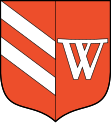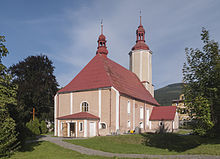Bolesławów
| Bolesławów | ||
|---|---|---|

|
|
|
| Basic data | ||
| State : | Poland | |
| Voivodeship : | Lower Silesia | |
| Powiat : | Kłodzko | |
| Gmina : | Stronie Śląskie | |
| Geographic location : | 50 ° 15 ' N , 16 ° 54' E | |
| Height : | 565 m npm | |
| Residents : | 250 | |
| Postal code : | 57-550 | |
| Telephone code : | (+48) 74 | |
| License plate : | DKL | |
| Economy and Transport | ||
| Street : | Stronie Śląskie - Nowa Morawa | |
| Next international airport : | Wroclaw | |
Bolesławów (German Wilhelmsthal also called Neustädtel , Glätzisch s Neistaatla ) is a village in the powiat Kłodzki in the Lower Silesian Voivodeship in Poland . It is located ten kilometers south of Lądek-Zdrój and belongs to the rural and urban municipality Stronie Śląskie .
geography
Bolesławów is located in the southeast of the Kłodzko Basin between the Kłodzko Snow Mountains and the Bielen Mountains . Neighboring towns are Stara Morawa in the north, Młynowiec in the northeast, Nowa Morawa and Kamienica in the south and Kletno in the west. In Bolesławów the rivers Morawka ( Mohrau ) and Kamienica ( Kamnitz ) join, which flow into the Biele at Strachocin . The border with the Czech Republic runs a few kilometers to the south .
history
On March 24, 1578, Emperor Rudolf II issued mining regulations for the County of Glatz and at the same time approved the Bohemian Oberstmünzmeister and Imperial Councilor Wilhelm the Elder. Ä. von Oppersdorf the establishment of a settlement in the royal forest Im Grund and Klessengrund south of Seitenberg. The settlement was intended to create living space for the miners of the surrounding silver and iron ore mines. At the same time the village of Johannesberg was laid out. Mohrau , Mühlbach , Kamnitz , Klessengrund and others followed in the next few years . All settlements were built on imperial forest land, which first had to be cleared.
Wilhelmsthal was founded as a free mining town in 1581 and named after the first name of the founder. Just one year later, a mining office was set up, headed by mountain master Paul Hautschel. The wooden church, built in 1582, served as a Protestant church until 1623. In 1584 the emperor granted the place various privileges, including the keeping of a coat of arms, a weekly market and two annual markets. The residents were always free from inheritance . In 1613 a grain mill was built. However, the privilege of brewing rights was withdrawn as a result of the class uprising in Bohemia and was not granted again until 1640.
Until 1684 Wilhelmsthal was chamber property of the Bohemian king. In that year, Emperor Leopold I sold several chamber villages in the County of Glatz to fight the Turkish wars . The Kammerdörfer in the Landecker district acquired the Governor Michael Wenzel von Althann . From these localities he formed the rule Seitenberg . After his death in 1686 the Seitenberg lordship, which did not belong to the majorate estate , inherited his widow Anna Maria von Aspremont-Lynden . From this she inherited her son, the Bishop of Waitzen, Cardinal Michael Friedrich von Althann , who sold her to Count Georg Olivier von Wallis in 1733, a year before his death . In 1739, Emperor Karl VI. the city of Wilhelmsthal has jurisdiction over all residents.
After the Silesian Wars , Wilhelmsthal and the County of Glatz came to Prussia in 1763 with the Peace of Hubertusburg . A conflagration caused great damage on December 26th, 1763, in which eight houses on the Ring burned down. In 1783 Stephan Olivier von Wallis sold the goods he had inherited from his father to Friedrich Wilhelm Graf von Schlabrendorf on Hassitz und Stolz. He sold the Seitenberg rule in 1789 to the royal judiciary Franz Bernhard von Mutius on Altwasser and Gellenau .
For the beginning of the 19th century: a parish church, a rectory, a school, a brewery and 65 private and town houses, in which 385 people lived. At that time the city consisted of the ring and three streets (Nieder- or Landecker Gasse, Küh- or Mährische Gasse and Wassergasse).
After the reorganization of Prussia, the municipality of Wilhelmsthal belonged to the province of Silesia from 1815 and was initially incorporated into the district of Glatz. On January 24, 1818, it was reclassified to the Habelschwerdt district , to which it belonged until 1945. From 1838 Princess Marianne of the Netherlands owned Seitenberg. The last owner was Prince Friedrich Heinrich of Prussia. With the decline of silver mining, Wilhelmsthal's economic importance declined, which is why it returned its town charter in 1892 and was downgraded to a rural community. In the same year the district of Wilhelmsthal was formed, to which the rural communities Kamnitz, Klessengrund, Neu Mohrau and Wilhelmsthal belonged. In 1939 there were 583 inhabitants.
As a result of the Second World War , Wilhelmsthal fell to Poland in 1945, like almost all of Silesia, and was renamed Bolesławów . The German population was expelled. Some of the new residents were displaced from eastern Poland , which had fallen to the Soviet Union . 1975–1998 Bolesławów belonged to the Wałbrzych Voivodeship (German: Waldenburg ).
Attractions
- The parish church of St. Joseph ( Kościół św. Józefa ) was built in 1672–1675 on the site of the earlier wooden church. The main altar dates from 1710. The Johannes Nepomuk altar and the sculpture of St. Josef in the main altar are Michael Klahr the Elder. Ä. attributed. The ceiling painting was created in 1906 by the Landeck painter Wilhelm Reinsch.
- The stone group of Mounts of Olives south of the church was erected in 1832. The figures represent Christ with the angel and three sleeping disciples on the Mount of Olives.
- The column with St. Franz Xaver was erected in 1717 to commemorate the victims of the plague of 1680 and 1713. The base is decorated with reliefs showing the symbols of death and impermanence.
Personalities
- Felix Jud (1899–1985), bookseller and anti-Nazi opponent
- Wolfgang Vogel (1925–2008), lawyer and negotiator for the GDR on the ransom of political prisoners
literature
- Joseph Kögler : The chronicles of the county Glatz . Revised by Dieter Pohl . Volume 1, ISBN 3-927830-06-2 , pp. 185-192.
- Dehio-Handbuch der Kunstdenkmäler in Polen, Silesia , Munich · Berlin 2005, ISBN 3-422-03109-X , p. 157.
- Verlag Aktion Ost-West eV: The Glatzer Land . ISBN 3-928508-03-2 , pp. 115-116.
Web links
Individual evidence
- ↑ Paul Klemenz: The place names of the County of Glatz: explained linguistically and historically = a contribution to Glatzer Heimatkunde , Breslau, 1932, p. 55, OCR version (server is difficult to reach)
- ^ Alfred Seipel: Wilhelmsthal - Your Ölberggeschichte In: Grafschafter Bote, Lüdenscheid, No. 4 (April) / 2011, p. 20.


